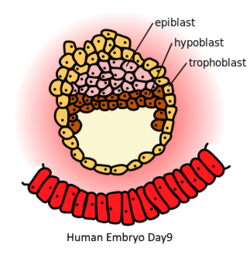
Back أريمة تحتانية Arabic Hipoblast BS Hypoblast German Hipoblasto Spanish Hypoblaste French Ipoblasto Italian Hypoblast Dutch Hipoblast Polish Hipoblasto Portuguese Гипобласт Russian
| Hypoblast | |
|---|---|
 | |
| Details | |
| Days | 8 |
| Precursor | Inner cell mass |
| Gives rise to | Endoderm |
| Identifiers | |
| Latin | hypoblastus |
| TE | E6.0.1.1.3.0.4 |
| Anatomical terminology | |
In amniote embryology, the hypoblast is one of two distinct layers arising from the inner cell mass in the mammalian blastocyst,[1][2] or from the blastodisc in reptiles and birds. The hypoblast gives rise to the yolk sac, which in turn gives rise to the chorion.[3]
The hypoblast is a layer of cells in fish and amniote embryos. The hypoblast helps determine the embryo's body axes, and its migration determines the cell movements that accompany the formation of the primitive streak, and helps to orient the embryo, and create bilateral symmetry.
The other layer of the inner cell mass, the epiblast, differentiates into the three primary germ layers, ectoderm, mesoderm, and endoderm.
- ^ Palmer, N.; Kaldis, P. (2016-01-01), DePamphilis, Melvin L. (ed.), "Chapter One - Regulation of the Embryonic Cell Cycle During Mammalian Preimplantation Development", Current Topics in Developmental Biology, Mammalian Preimplantation Development, 120, Academic Press: 1–53, doi:10.1016/bs.ctdb.2016.05.001, PMID 27475848, retrieved 2020-10-16
- ^ Keefe, David L.; Winkler, Nurit (2007-01-01), Sokol, Andrew I.; Sokol, Eric R. (eds.), "Chapter 1 - Embryology", General Gynecology, Philadelphia: Mosby, pp. 1–20, doi:10.1016/b978-032303247-6.10001-2, ISBN 978-0-323-03247-6, retrieved 2020-10-16
- ^ Hafez, S. (2017-01-01), Huckle, William R. (ed.), "Chapter One - Comparative Placental Anatomy: Divergent Structures Serving a Common Purpose", Progress in Molecular Biology and Translational Science, Molecular Biology of Placental Development and Disease, 145, Academic Press: 1–28, doi:10.1016/bs.pmbts.2016.12.001, PMID 28110748, retrieved 2020-10-16
© MMXXIII Rich X Search. We shall prevail. All rights reserved. Rich X Search